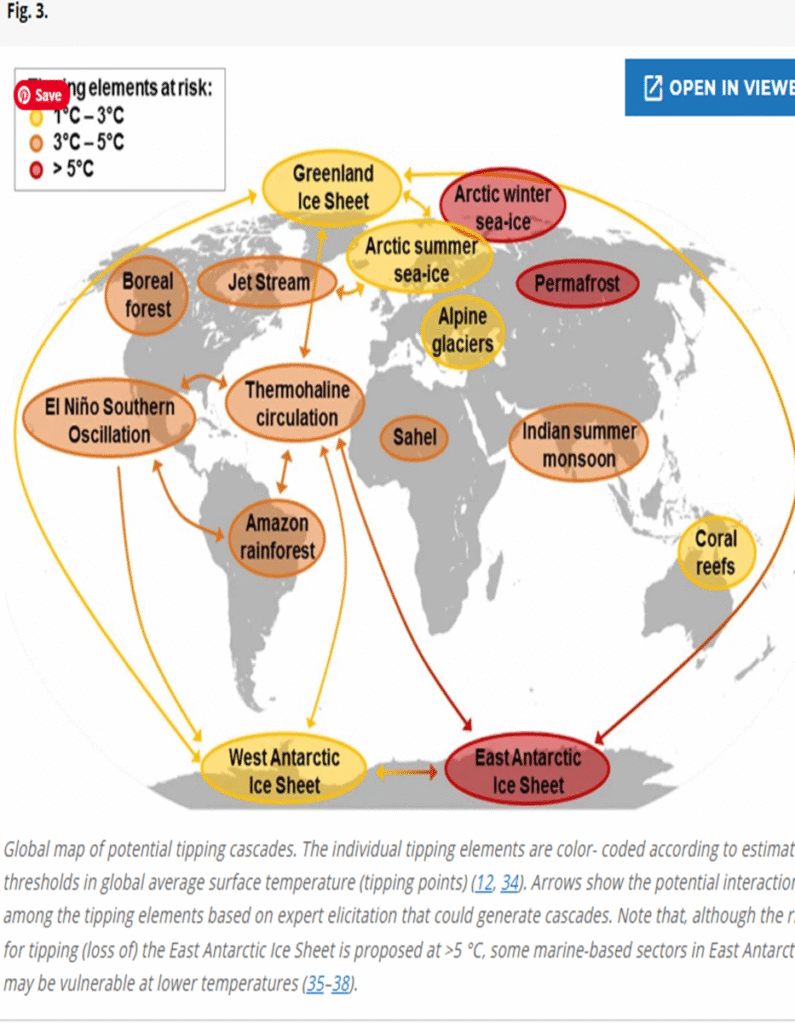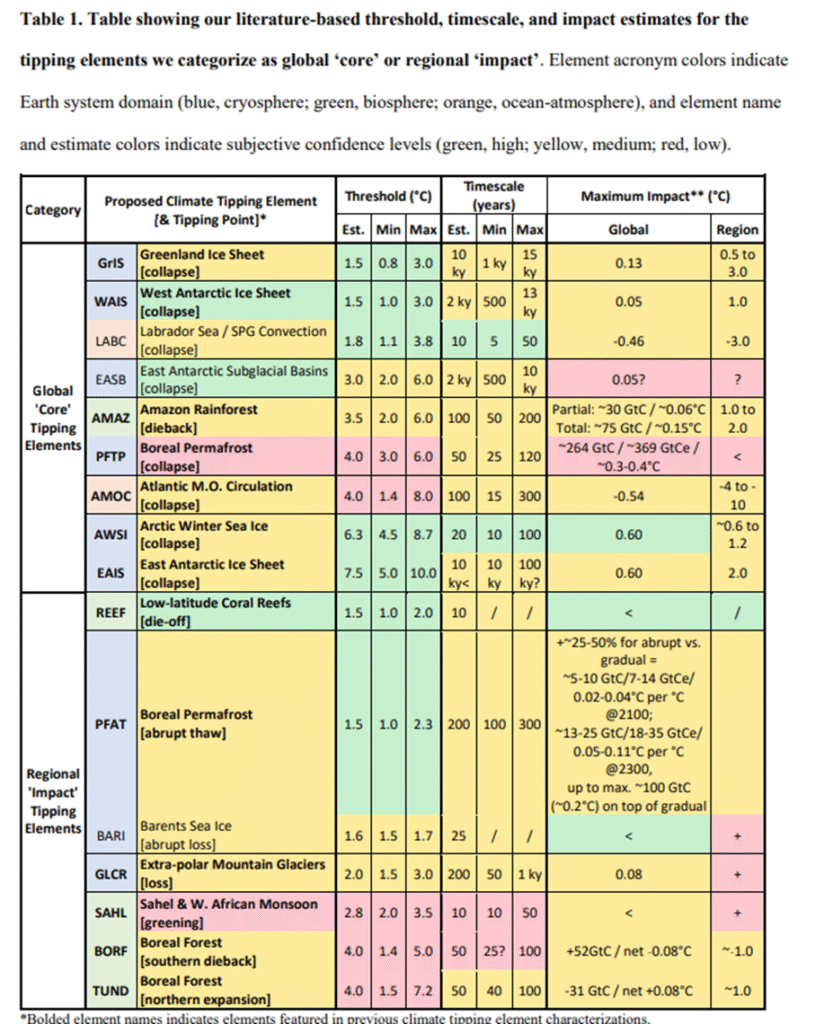Context – Tipping Points Introduction
Contents
- What are they – Feedbacks, Tipping Points
- Major Tipping Points
- Other Feedback Systems
- Links to other Feedback and Tipping Point Context Articles
(Article Note – All source references used are highlighted and linked in the Article. Direct quotations are presented in italics with additional emphasis highlighted in maroon.)
1. What are Feedbacks and Tipping Points
Overview
The main driver of climate change; the Earths Energy Imbalance (EEI), where more solar radiation heat is being absorbed by the Earth’s surfaces (atmosphere, land and sea) than is being reflected back to space, is directly linked to the increase in the amount of greenhouse gases (primarily carbon dioxide and methane) in the atmosphere trapping that heat, broadly in a closely linear manner so that the increase in temperature corresponds directly to an increase in greenhouse gases.
The IPCC 6th Assessment Report, Working Group 1 Technical Summary indicates that the climate changes generally correspond to the increase in temperatures: ‘the present rates of response of many aspects of the climate system are proportional to the rate of recent temperature change’ (page 106). However it goes on to issue the critical qualification for these purposes ‘that some aspects may respond disproportionately’. It is an understanding of what those aspects may be, how and when they may respond and what the effect would be that are considered in this this series of Context articles on climate system feedbacks and tipping points
Key Features:
Feedbacks–
The Earth system is itself a conglomeration of a number of different but interconnected systems that impact on each other and trigger further changes in response to disturbance or feedbacks. These feedbacks can either be negative or positive in the sense that negative feedbacks suppress the initial stimulus and thus stabilise the system bringing it back into balance while positive feedbacks do the opposite by reinforcing the initial stimulus and thus tend to destabilise the overall system.
In terms of climatic heating, a negative feedback tends to dampen the initial heating impact and bring the temperature back towards the existing equilibrium state whilst a positive feedback response tends to amplify the heating stimulus; warming leading to more warming which in turn drives further warming. However an important point is that generally positive feedbacks do not tend to spiral out of control or ‘runaway’ as the further cycles of feedbacks weaken progressively and drive smaller system responses.
In the geological past, negative feedbacks predominated (except at times of transitions to different states such as the changes from ice-ages to interglacial periods and visa-versa) however, with the relentless and accelerating accumulation of greenhouses gases in the atmosphere from the start of the Industrial Age, positive feedbacks have come to predominate. As well as accelerating global heating, positive feedbacks can also trigger changes in other connected climatic systems as will be seen in examples such as the collapse of coral reefs triggering a range of other ecological and socio economic negative impacts.
Another related factor is how a number of stressors combine so that the cumulative impact results in the collapse of a system which any one stressor in isolation the system would be resilient to. A good example of this is the Amazon forest where the fundamental driver of atmospheric heating leads to drought conditions which in turn drives forest wild fires and, combined with sustained human forest clearance, all together weakens the resilience of the rainforest which may be able to withstand one stressor alone better, can result in major loss of this ecosystem and change to treeless savannah grasslands .
Tipping Points –
In recent years, starting with a two hugely influential academic articles; the first in 2007 by Timothy Lenton (and others) titled Tipping elements in the earth’s Climate System and a second in 2018 by Will Steffan (and others) Trajectories of the Earth System in the Anthropocene; there has been a major realisation of the danger of certain positive reinforcing feedback loops which have the potential to push certain earth systems across certain thresholds resulting in a fundamental change to the particular system and seriously weaking other connected systems. The IPCC in the 1.5 Degree Special Report defines a Tipping Point as
‘A level of change in system properties beyond which a system reorganizes, often abruptly, and does not return to the initial state even if the drivers of the change are abated. For the climate system, it refers to a critical threshold when global or regional climate changes from one stable state to another stable state. See also Irreversibility.’
The basic dynamics of feedbacks and tipping points are clearly presented in the following extract and diagrams from Climatetippingpoints.info: What are Climate Tipping Points? – climatetippingpoints.info
The key driver of tipping points are positive feedback loops. Strong positive feedback loops can quickly amplify small changes – this happens when a change in A leads to a change in B which in turn produces more change in A and so on. This is what happens when you hear feedback from a mic and a speaker being too close to each other – the noise picked up the mic is amplified by the speaker which is picked up by the mic again.

In the climate system, an example of a positive feedback loop is the ice-albedo effect (illustrated above) – less sea ice due to warming results in a darker sea surface overall, which reflects less heat, raises local temperatures, and leads to yet more sea ice loss. If this process isn’t stopped by a negative feedback then a tipping point is hit beyond which a large shift to a new state becomes inevitable.

You can think of tipping points as being like a see-saw – before the pivot you have to keep pushing the ball yourself, but after the pivot the ball rolls away quickly without any further pushing. This is an example of a gradual change (like increasing temperature) hitting a critical threshold beyond which the change becomes self-perpetuating until a ‘new normal’ is reached. Once you’re past a tipping point it’s more difficult to get back – the system has found a new stable state.
There are many potential tipping points in the climate system that could significantly affect us – visit ‘How may Climate Tipping Points affect us?‘ to find out more.
Climate Tipping Points – Characteristics –
Key features of the IPCC tipping point definition as further detailed by Carbon Brief and in the Global Tipping Points Report 2023 are:
- Abruptness – so that the impact changes from being linear progressive responses to one in which a system has reached a critical level of instability so that a small further increase in the stress results in a total collapse in the system. Not all systems behave in this abrupt shift but ones that do are likely with sufficent stress to experience a sudden collapse such as the Amazon forest or coral reef ecological systems.
- Unpredictability – a second feature of tipping points is that because of the complexity of earth systems, the interactions are not fully understood and not accurately modelled. In particular, the point at which a system reaches a threshold of instability and suddenly transitions to another state cannot be defined in advance with accuracy. Nevertheless with the growing awareness more efforts have put to making these assessments and the estimates will be indicated in the further analysis.
- Irreversibility – a defining feature of a tipping point is that the change is irreversible meaning that if the stressor stops or is reduced, the system does not revert to its previous state, not at least in any relevant human time-scales (decades or hundreds of years), as the system has moved into a new state of equilibrium – this irreversibility aspect of a tipping point is technically described by Lenten et al in the 2007 paper as ‘hysteresis’ or ‘system bifurcation’. Examples are ice sheet melting (which the IPCC described as ‘virtually certain’ that irreversible committed change is underway such as the melting of the Greenland Ice and Antarctic ice-sheets although the full melting will be slow (over decades to hundred of years) rather than abrupt.
- Massive Scale of Impact – this aspect emphasises that such tipping points have a major impact at the regional or global level. The Tipping Point Report 2023 indicates that the Amazon die-back alone would be a catastrophe for global as much as for the biodiversity in the specific region and put 6 million people at direct risk of extreme heat due to the local temperature regulating feature of the Amazon. The collapse of the gulf stream ( as part of the Atlantic Meridional Overturning Current ‘AMOC’), another high risk tipping point, would either significantly reduce or completely stop the flow of warm current from warmer tropics to the northern regions, directly impacting North West Europe and substantially reduce food production.
- – Cascade Effects What the IPCC definition above does not indicate, but what was so starkly highlighted in the 2018 Steffan article referenced above, is that these major tipping points can impact and trigger each other so it is possible that a cascade effect of impacts occur, a ‘domino effect’ or as described by Carbon Brief (link above) or a jenga tower collapsing when just one more brick has been removed beyond the limit of self-standing support.
- The Steffan article first introduced the term ‘Hothouse Earth’ to describe the nightmare scenario that the cascading of such major tipping point triggering where all negative feedbacks are essentially lost and the earth spirals into a runaway heating rise as happened in the geological past and indeed occurred on Venus and destroying all advanced forms of life in the process. The cascading pathway was described in the attached diagram in the article with very broad temperature threshold estimates which have since been updated but the potential interconnections essentially remain :

2. Major Tipping Points
Another very influential paper, Exceeding 1.5C global warming could trigger multiple climate tipping points, published in 2022 by David Armstrong Mckay and others, presented an updated assessment of what are considered to be the most important tipping elements and tipping points including an analysis of their temperature thresholds, timescales and impacts gained from a study or most recent and significant research papers. It divided the climate tipping elements into global (core) tipping elements and regional impact tipping elements and following is a table summary (ky = 1000 years).

The following table is a more narrative description of the one above, presenting in a more simplified form factors for abrupt change and irreversibility.

Of particular concern from the list is the Atlantic Meridonal Overturning Current (AMOC) which it indicates could collapse at 1.4 degrees or in 15 years time (minimum estimated time-frames) and the Amazon rainforest in a timeframe of 50 years and temperature increase of 2 degrees as well as coral reefs which are expected on current heating trajectories to die within the very short timeframe of 10 years with only small remnants surviving.
Based on average 1.1 degrees of warming alone, which has since been passed (heading towards average of 1.5 degrees now), low end estimates for 5 tipping points have already been passed and at 1.5 degrees the West Antarctic Ice Sheet, the estimated tipping point is reached, adding several meters sea level rise though over a very long melt timeframe in human terms (500 years minimum).
3. Other Feedback Systems:
As well as these major Tipping Point systems, there are a large number of other feedbacks operating in the climate system which may not receive the apocalyptic levels of danger as the major tipping points but which all contribute towards driving climate systems into an accelerated rate of global heating. Some of these are listed and briefly described below:
- Soil and Peatland Drying Feedbacks – warmer temperatures drying out soil and peat.
Impact – the drier soil has reduced transpiration which helps to cool the land resulting in more heating effect. The drying peatland releases CO2 which leads to further warming. But regional impacts but significant where they occur, contributing to desertification. - Tundra Vegetation Feedback – as the Arctic warms, vegetation such as shrubs and small trees expand which absorbs more solar radiation than the barren tundra ground and further increases the land. Impact – regional warming in tundra zones, especially in the Arctic.
- Phytoplankton feedback – phytoplankton populations decline in warmer oceans. As phytoplankton absorbs CO2 and reflects sunlight the decline reduces the carbon sink and the relective cooling effect.
- Ocean Stratification feedback – As surface oceans waters warm they become less dense and lead to stratification between the warmer upper layer and colder deeper waters which in turn limits the oceans ability to absorb further heat and CO2. It also impacts nutrient upwelling from the depths which impacts on fish and marine ecology.
- Boreal forest fire feedback – As well as forest loss from drought, forest fires in drought conditions are more frequent and the burning releases large amounts of carbon driving further warming. As the fires also melt snow, the reflective effect is lost and more sun radiation is absorbed.
4. Links to other Feedback and Tipping Point Context Articles
Some of the major tipping points are considered further in Context Articles in this series with links as follows:
